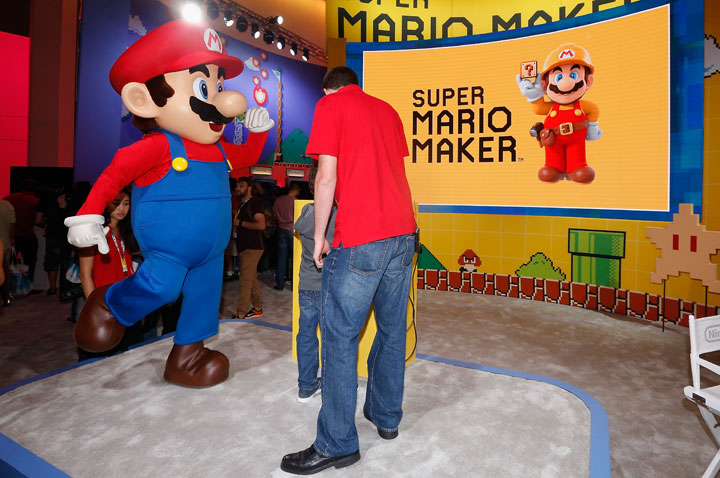TORONTO – Small-town Ontario in the mid-1980s provided limited lunch-break opportunities for my high school classmates. The cool kids played euchre in the cafeteria, the industrious kids toiled in the computer lab, the bad kids smoked in the parking lot.

I did none of those things. Instead, my friend and I would take a supply of quarters to a seedy corner store on a deserted lane that ran off the main street. Past the jars of stale candies and racks of water-damaged comic books stood the only “Super Mario Bros.” arcade cabinet within a reasonable bike ride of my school.
Not only were we in love with the game, but the store promised a free Walkman to the first person who beat the final stage. We probably spent enough money to buy a whole stereo system trying to reach that brass ring, but when my friend finally completed World 8-8 and was begrudgingly handed the portable cassette player by the store’s taciturn owner, it felt like we were part of an achievement that would stand the test of time.
READ MORE: ‘Super Mario Bros.’ creator Miyamoto’s new challenge? Theme park designer
It would not. The store closed down, the Walkman became obsolete and my friend and I lost touch after graduation. The only thing to survive from those lazy lunch periods is the squat moustachioed plumber with a penchant for stomping on turtles and rescuing royalty.
Nintendo’s iconic Super Mario celebrates his 30th anniversary on Sunday, and over those decades he has evolved from a mere video game character to an enduring pop culture phenomenon. He recognizable image has graced hundreds of games as well as toys, breakfast cereal, cartoons and even a forgettable 1993 major motion picture, where he was portrayed by British actor Bob Hoskins.
He has never gone out of style, an amazing feat given the fickle nature of the pop culture consumer. In popular music terms, he has outlasted Debbie Gibson’s “Shake Your Love,” Wreckx-N-Effect’s “Rump Shaker” and Kelis’ “Milkshake.” He will probably still be around when we all have forgotten Taylor Swift’s “Shake It Off.”
“To be able to have that kind of love for a character even after 30 years … it speaks volumes about how great a job they did originally when they created him,” Andrew Collins, communications manager at Nintendo Canada, said in a phone interview. “I’ve worked on a lot of big games, but nothing compares to the fans’ emotion with Mario.”
Mario hasn’t always been super. In fact, the character made his debut in 1981 during the golden age of video games as the protagonist of the arcade hit “Donkey Kong.”
Back then, Mario’s powers were more prosaic. He could jump or use a hammer as he scaled construction sites to rescue a damsel in distress from a barrel-tossing gorilla.
While the character was popular, he was considered a second banana to Pac-Man, the video game industry’s first superstar. But things changed on Sept. 13, 1985, when “Super Mario Bros.” was released in Japan. No longer hanging around construction sites, Mario now had to navigate the fantastical Magic Kingdom in a quest to rescue a princess from Bowser, a bellicose turtle/dragon hybrid who, in later games, would become Mario’s biggest nemesis and occasional ally.
The biggest difference between Super Mario and his pedestrian predecessor was Super Mario’s super powers. Eating a mushroom would make Mario super-sized and capable of smashing brick walls. A glowing flower gave him the ability to hurl fireballs at his enemies.
The game became a huge hit in both Japan and North America. It didn’t hurt that a “Super Mario Bros.” game cartridge was bundled with the popular Nintendo Entertainment System – the console credited for resurrecting a struggling video game industry in North America.
“I had a friend who had an NES, and I used to go round to her place so often that my mom said to me: ‘Do you like her or do you just like her Nintendo?’ Collins said.
“I’m still good friends with her now; she’s one of my oldest Facebook friends. But the fact is she had this Nintendo that allowed my to play ‘Super Mario Bros.,’ Duck Hunt and those games … My 11-year-old self didn’t understand what a draw that would be later in life.”
Nintendo says Super Mario has appeared in 273 games, and he has branched out from saving princesses. He’s the face of the hugely popular “Mario Kart” racing series, and has tried his hand at golf, soccer, and tennis. He’s competed at the 2010 Vancouver Olympics. He’s even tried distributing pharmaceuticals in “Dr. Mario,” Nintendo’s answer to Tetris.
READ MORE: Nintendo World Championships return after 25 year hiatus
And he’s done most of this without saying a word. Mario has been mostly silent in his hundreds of game appearances, something Collins said sets him apart from other characters who are heavy on attitude.
“He’s kind of like an Italian plumber meets Charlie Chaplin,” Collins said. “He’s a great example of something where you don’t necessarily need a script because Mario works so well in every language, and I think that part of his appeal.”
And new Super Mario games have introduced new powers. While the classics like super size and fireball remain, he has also been able to turn into a frog, flying raccoon or penguin.
Of course, everyone has their personal favourite.
“I love the cat suit,” Collins said. “It’s the one that my son gets energized by the most when he sees it. I don’t know whether I’m a good dad or a bad dad, but I’m very happy for him to sit on my knee and watch me play.”



Comments